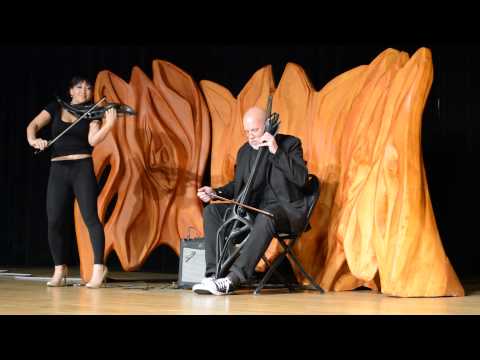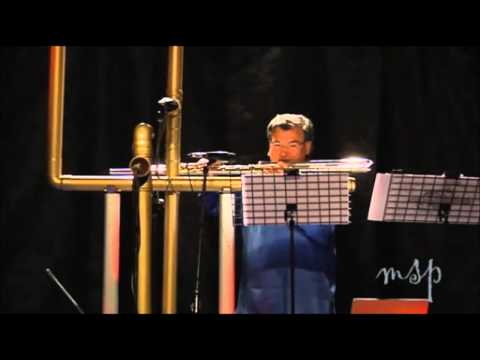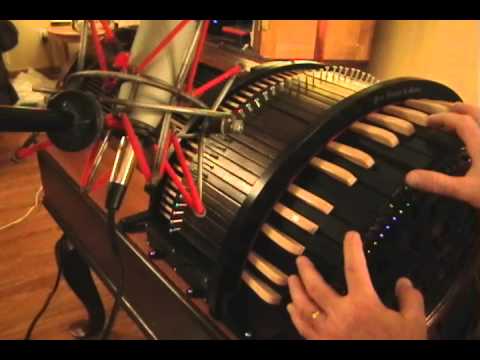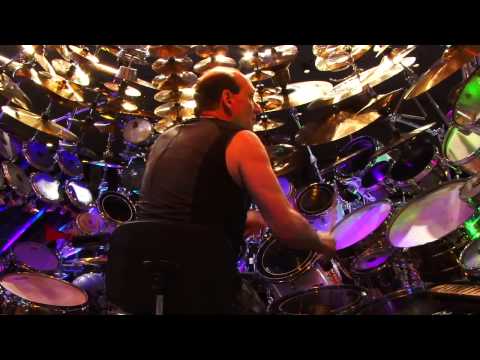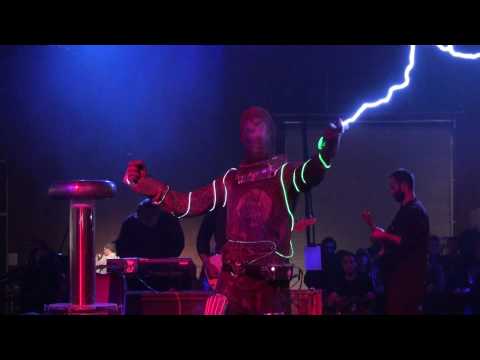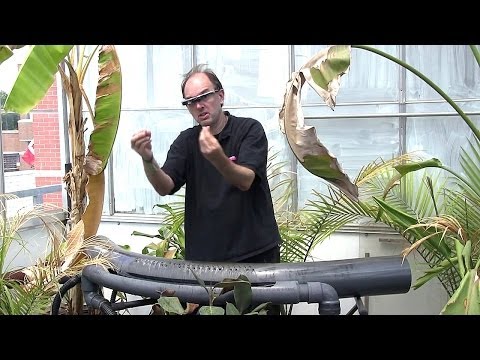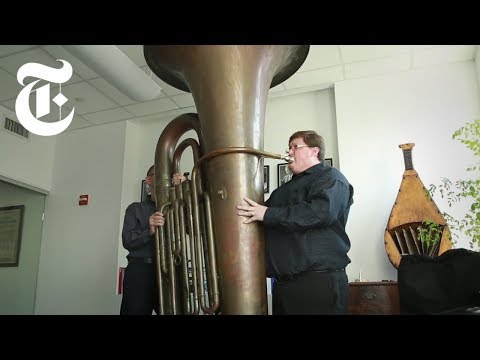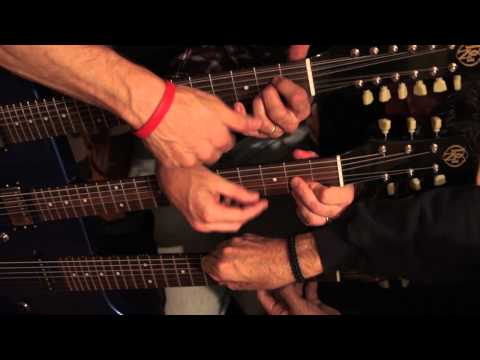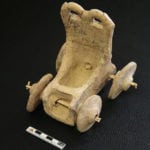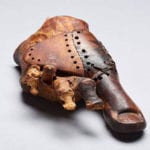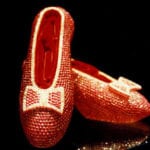10 Two-String Piezoelectric Violin
In 2015, 3-D printing studio MONAD entered the music world with its unique, beautiful instruments. The most exciting was the two-string piezoelectric violin. This unwieldy instrument looks like something out of a science fiction movie and is specifically designed to create an array of sounds that are different from those of a normal violin. The two-string piezoelectric violin was also a part of MONAD’s 3-D printing exhibition. MONAD designed four other instruments to be played with the violin. These instruments integrate into a large, 3-D sculpture that can amplify and produce new sounds. The sculpture is also capable of warping the sounds of the instruments to create dynamic soundscapes that combine art and music into a single presentation. In performance, the violin’s otherworldly sounds were well received, if a little disconcerting at first.
9 Hyperbass Flute
Although most people think of flutes as instruments that produce ear-piercing high notes, flute enthusiasts have been moving toward designing bigger flutes that create deeper notes. So far, the biggest one is the hyperbass flute. Invented by Roberto Fabbriciani, the flute can play extremely low notes, some of which are beyond the range of human hearing. Still, Fabbriciani records music and plays his flute in concert, even if some of the notes are impossible to hear. After Fabbriciani’s design sparked interest in the flute community, low flute specialist Peter Sheridan commissioned the design of his own hyperbass flute. Sheridan’s flute is a tremendous improvement over Fabbriciani’s instrument because Sheridan’s flute has the same range of notes as normal instruments. Although Sheridan’s flute also plays notes that are impossible to hear, he is exploring ways to get even lower frequencies out of his flute.
8 Wheelharp
The wheelharp is an experimental instrument created by Antiquity Music to replicate the experience of listening to a string orchestra. The various strings of the wheelharp sound like the orchestra’s string instruments, including the violin, viola, and cello. Most importantly, the wheelharp produces string sounds that can’t be replicated authentically by synthesizers. Replacing the bow with a spinning wheel and keys, the wheelharp is played like a normal keyboard instrument. So a single person can play complex pieces that usually require multiple musicians. Of course, this instrument is not easy to master. The musician must use pedals to dampen certain strings while rotating the wheel at the right speed. This makes the correct strings play. Although Antiquity Music designed the instrument to look Victorian, it has a piezo pickup system in the soundboard to amplify the sound. In 2013, Antiquity Music set a $50,000 funding goal on Kickstarter to make their instrument commercially available. During their 30-day funding period, they were able to raise less than $9,000.
7 Mark Temperato’s Drum Kit
In 2013, Mark Temperato set a Guinness world record for the largest drum kit—813 pieces, all of which are playable. Although the kit weighs 2.5 tons and takes 15 hours to assemble, Temperato can hit each piece without taking a step from his chair. It takes him one hour to hit all of the pieces. Currently, this gigantic drum set resides at the Breath of Worship Church in Lakeville, New York, where Temperato is a reverend. Known as “RevM,” he uses his drum kit to spread the Word of God. According to Temperato, that was the main reason he created this insane instrument. Every year, the drum set brings people into the church, mostly to see and hear him play. When they come, they also get a sermon from RevM.
6 Zeusaphone
Tesla coils are impressive pieces of technology. They are excellent sources of power that can put on dazzling electric shows for crowds. But performance group ArcAttack, led by the DiPrima brothers, takes the Tesla coil to a whole new level. By modulating the spark output of the coils, the DiPrimas can generate audible notes and make music with two Tesla coils. Due to the shocking nature of the device, the instrument is known as the zeusaphone. At first, ArcAttack was content with just playing the zeusaphone for crowds. But lately, they have upped the ante. During performances, ArcAttack member Patrick Brown wears a Faraday suit that makes him impervious to electrical charges. This allows him to make contact with the electricity coming from the Tesla coils without being electrocuted. Although the zeusaphone itself is not impressive musically, the sheer spectacle of the performances keeps people coming back.
5 Sea Organ
The Croatian coastal city of Zadar suffered massive devastation during World War II. After the war, city officials undertook a hasty reconstruction project that repaired much of the infrastructure but ignored aesthetics. This left a lot of ugly concrete structures in the city, especially on the coastline. Croatian architect Nikola Basic got approval to make part of the concrete seawall more aesthetically pleasing while contributing to the culture of Zadar. In 2005, he unveiled the completed project—a giant sea organ on the coast. On the surface, the sea organ consists of concrete steps with little openings on the front edge. These openings lead to 35 organ pipes beneath the structure. When the water and wind crash against the steps, they create music that can be heard by people nearby. The music is haunting and rhythmic, making the sea organ one of the most popular tourist attractions in Croatia.
4 Hydraulophone
The hydraulophone uses water to make musical notes. The instrument consists of holes that have water shooting out of them. By covering one of the holes with his finger, a musician can redirect the water into sound-producing equipment, such as a reed, perforated disk, or valve. Playing a hydraulophone is like playing a piano. These instruments are generally used at concerts or as art installations. Builder Steve Mann has created a variety of hydraulophones, but the most striking are those based on hot tubs. They allow the musician to sit in a warm hot tub while playing music. These instruments also have a more practical value. The tactile nature of the user interface makes it ideal for blind people who wish to learn an instrument. Mann has also done human-computer interface experiments.
3 Big Carl
In New York City, Carl Fischer Music owns the world’s biggest tuba, known as Big Carl. The first rumored appearance of the gigantic tuba was the 1904 World’s Fair in St. Louis. It may have been built in the late 1800s, but nobody has definitive records about Big Carl’s origins or travels. Big Carl is not a true tuba. The instrument does not have a full range of notes. Instead, it can only play fundamental notes. It also requires a team of people to make sure that it does not tip over. The instrument produces deep, resonant tones that are comparable to a jackhammer or a helicopter flying overhead. Currently, the owners of Big Carl are trying to verify that it is the world’s biggest tuba.
2 Eight-Necked Electric Guitar
Rock music is known for its spectacle and excitement. Over time, various rock musicians have adopted unusual instruments, including revamped versions of older instruments. Much of the experimentation has involved guitars, culminating in the eight-necked electric guitar. The best-known playable eight-necked guitar is Rock Ock. Designed by Gerald Huerta, this massive instrument features many different types of guitars, all of which work if he can find enough people to play them. For years, Rock Ock was the only playable eight-necked guitar. But in 2014, guitarist Justin Stone joined the club with Rocktopus, his eight-necked beast. Rocktopus has its necks arrayed like an eight-point star. Although this giant instrument is also completely playable, setting it up is a hassle.
1 Sharpsicord
When you look at the sharpsicord, it’s difficult to figure out exactly what it does. Designed by Henry Dagg, the instrument is essentially a giant music box. A perforated cylinder drives the instrument by automatically playing a 46-string harp. By inserting various pins into the cylinder, a musician creates his or her own musical arrangement that plays automatically as the cylinder spins. To play 60 seconds of music, Dagg has to spend nearly a day arranging the pins in the cylinder. Weighing 2.5 tons, this huge instrument is labor-intensive and consumes a lot of power. So Dagg made the sharpsicord solar-powered. Finding a home for the sharpsicord has been a challenge for Dagg. Originally designed under a grant from the English Folk Dance and Song Society, the instrument proved too complex for the organization’s requirements. They wanted an outdoor installation, which would make it nearly impossible to keep the instrument in tune. The sharpsichord would also require intensive maintenance in that environment. Fortunately for Dagg, the Society decided on the outdoor aspect after the instrument was constructed. The most famous use of the sharpsicord occurred when Icelandic musician Bjork used the instrument on her album Biophilia and in subsequent tours. Zachery Brasier is a physics student who likes to write on the side. Check out his blog at zacherybrasier.com.
